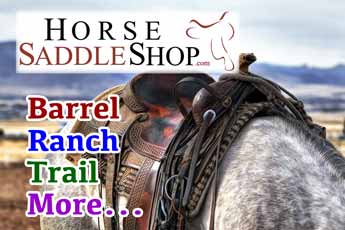Cowboy Dictionary - Letter C
Calf - A young animal belonging to the genus Bos, which includes the species cattle. A calf can be either male or female. The plural of "calf" is "calves."
Camouflage - The ability to blend in with surroundings in order not to be noticed. In the animal kingdom, camouflage is an important safety factor many animals use in order to hide from predators.
Below: A Brahman, Simmental cross calf lies camouflaged in the grass.
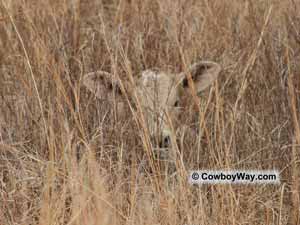
Catch Pens - At a rodeo arena, the "catch pens" are the pens that hold the calves and steers used in timed events after they have finished their run in the arena.
We have more information about the catch pens, and why they are important to the performance of the calves and steers.
Cattle - An animal belonging to the family Bovidae, genus Bos, and species cattle. "Cattle" is a plural term used to refer to more than one animal.
Cattle Guard - A device set into the ground designed so that vehicles can drive over it, but livestock will not want to cross it.
Below is a common style of cattle guard. A hole was dug into the ground, then the cattle guard, a series of heavy, 2 inch pipes with gaps in between them, was set over the hole.
Below: A cattle guard.
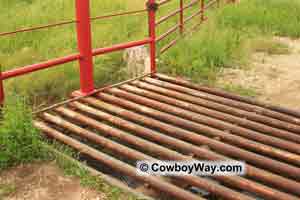
Advertisement - Article continues below.
Chaps (pronounced "shaps") - Leather leg coverings worn by cowboys and cowgirls for protection against weather, trees, brush, kicks, rope burns, and other hazards.
There are two common styles of chaps: Shotgun and batwing. Both styles buckle around the waist and are open in the back so a rider's seat is not covered. After that, there are several differences.
-
Shotgun chaps get their name from their straight design, similar to a
shotgun barrel. They are the original style of chap for working cowboys. Shotgun chaps run the full length of the leg, and are typically closed
around the leg from top to bottom.
Modern shotgun chaps are usually made with a zipper or other fasteners running from the top of the leg to the bottom to make them easy to put on and take off.
Older shotgun chaps - or new ones designed on an older style - might be enclosed from top to bottom requiring the rider to step into them like a pair of jeans. -
Batwing chaps are a style that came along after shotgun chaps. Batwings
also run the full length of the leg, but are typically only closed around
the leg from the top of the chap to just above the knee. Buckles, snaps, and
other fasteners are common.
Batwing chaps are fuller cut than the shotgun style, having a generous amount of leather that overlaps the leg.
Below: Shotgun chaps.
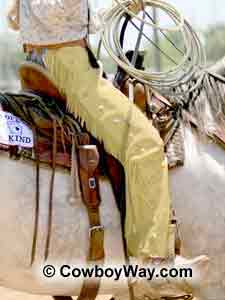
Below: Batwing chaps.
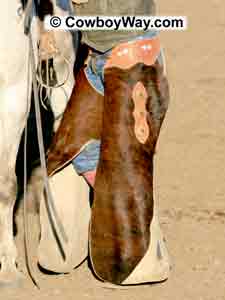
You can shop for chaps here.
Chestnuts - Horse chestnuts are normal, healthy growths found on most horse's legs. No one really knows why they exist, and they have been a subject of curiosity among horsemen for quite a long time.
Chestnuts appear on the front legs of a horse above the knee, or on the back legs of a horse below the hock. They can be large or very small. Some people call horse chestnuts "night eyes."
Below: A close-up look of a horse chestnut on a horse's front leg.
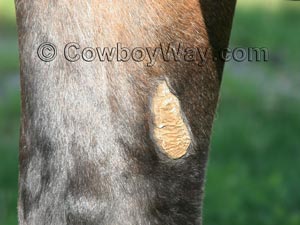
We have more information about horse chestnuts and ergots.
Chinning - "Chinning" is a behavior sometimes seen in cattle when they are considering jumping a fence or other obstacle.
When a cow (or bull, steer, etc.) "chins" a fence, she elevates her head slightly and puts her chin on, or very close to, the top rail. This seems to be her way of measuring the fence for height, and helps her decide whether or not to attempt to jump it.
Chinks - This definition has its own page. Please see What Are Chinks?
Clotheslined - Running into, or being ran into by, a solid object, and getting knocked off of your horse. For example, if a rider gallops under a tree and runs into a branch, an observer might say: "Wow, he sure got clotheslined by that tree limb."
Below is a photo of a ranch rodeo contestant getting clotheslined in the wild cow milking event. While getting clotheslined can be an embarrassment for a cowboy, we think a case like this is an exception. This was a cowboy who knew the risks but was willing to take chances in order to get a fast time for his team. After he was knocked off his feet he still hung onto the rope and slowed the cow so his teammates could catch up.
Below: A cowboy getting clothslined.
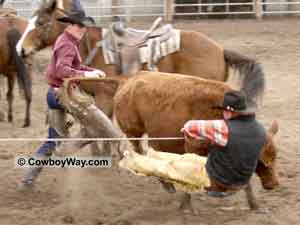
Working cowboys and cowgirls are sometimes clotheslined by ropes, such as in the photo above. If a roper catches a calf (or cow, etc.) and dallies, the rope between the calf and the horse can become a potential hazard. Other nearby riders or ground crew on foot are sometimes clotheslined with the rope, which can spook horses or knock people down.
To get clotheslined is usually an embarrassment for the roper and/or the other riders or persons that get clotheslined. Cowboys in and out of the saddle take pride in understanding and avoiding the potential dangers involved with roping.
Cold-Backed (Definition 1 of 2) - A horse that is broke to ride, but bucks when ridden for the first time that day or after a layoff of several days or longer.
Cold-Backed (Definition 2 of 2) - A horse with an overly sensitive or painful back.
Colt - A colt is a young male horse, 4 years old or younger. It is also sometimes used as a more generic term to refer to any young horse regardless of gender.
Cow (Definition 1 of 2) - A mature female animal belonging to the genus Bos, which includes the species cattle. Some females of other large animals, such as elephants and whales, are also called cows.
- Cows are
ungulates. "Ungulate" means they are a mammal with hooves. Cows are
even-toed ungulates (called Artiodactyls) and horses are odd-toed ungulates
(called Perissodactyls).
- More examples of even-toed ungulates include pigs, goats, sheep, and camels.
- More examples of odd-toed ungulates include rhinoceroses and zebras.
Below: A Texas Longhorn cow
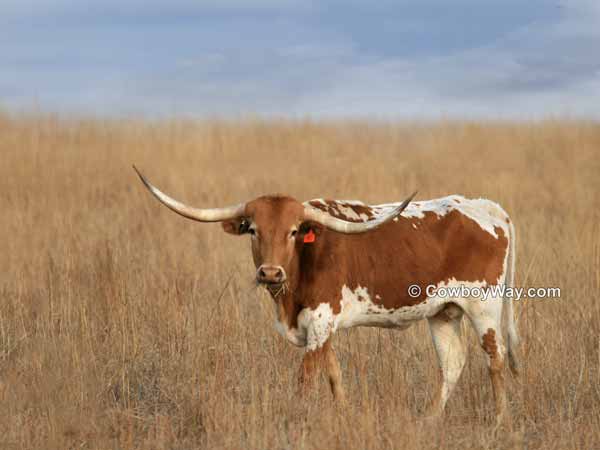
- Cows are ruminants. A
ruminant is an even-toed animal that digests its food
by first swallowing it, then regurgitating it later to re-chew and re-swallow
it. This process may be repeated several times.
- The regurgitated food is referred to as a "cud."
- Ruminants have four different digestive chambers. The chambers are the rumen, reticulum, omasum, and the obamasum.
- Ruminant animals like cows are very efficient at extracting the most nutrition possible from poor quality feed.
- More examples of ruminants include goats, sheep, deer, llamas, bison, and buffalo.
- The gestation period for a cow is nine months
- Some common "cow" terms:
- Cattle - An animal belonging to the family Bovidae, genus Bos, and species cattle. "Cattle" is a plural term used to refer to more than one animal.
- Calf - A young member of the genus Bos. A calf can be either male or female. The plural of "calf" is "calves."
- Heifer - A young female member of the genus Bos. When a heifer matures, she is called a cow.
- Cow - A mature female belonging to the genus Bos.
- Bull - A male belonging to the genus Bos.
- Steer - A castrated male belonging to the genus Bos.
- Ox - A male belonging to the genus Bos that has been castrated after having reached sexual maturity. The term can also mean any member of the Bos genus (usually male, but can also be female) that is used for draft work. The plural of "ox" is "oxen."
While the word "cow" is properly used to define a mature female, among cowboys and others in the livestock industries the term is sometimes used to loosely describe any member of the cattle species.
For example, a "cow sale" is a sale that sells cows, but it might also sell bulls, calves, and/or steers and heifers. When used like this the the term "cow" is slang for any bovine, and its usage is not considered to be incorrect.
You can shop for cow posters here.
Cow (Definition 2 of 2) - A way of describing a horse's innate ability to read and handle cattle. For example: "That horse sure has a lot of cow," or " That horse is sure cowy". Not all horses have cow, and among cowboys and cowgirls describing a horse as having cow, or being cowy, is a compliment.
Cowboy - Someone who takes care of cattle, primarily on horseback. Cowboys typically have excellent horsemanship and roping skills, and an extensive knowledge of horse and cattle husbandry.
Cowgirl - A female cowboy.
Crow Hop - A crop hop is a type of bucking in horses. We have more information about a crop hop, including a photo.
Crupper - A strap that runs from the back of the saddle or harness along the top of a horse or mule's rump, then underneath the tail. The purpose of a crupper is to keep the saddle or harness from sliding too far forward.
Below: A crupper.
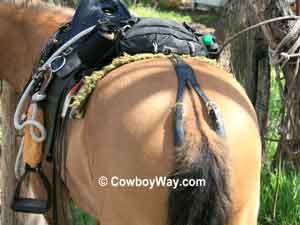
Definitions
… Letter C
… Letter S
… Letter T
You Might Also Like
